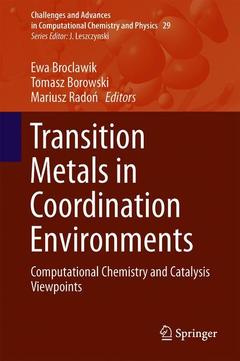Description
Transition Metals in Coordination Environments, 1st ed. 2019
Computational Chemistry and Catalysis Viewpoints
Challenges and Advances in Computational Chemistry and Physics Series, Vol. 29
Coordinators: Broclawik Ewa, Borowski Tomasz, Radoń Mariusz
Language: English
Subjects for Transition Metals in Coordination Environments:
Keywords
Transition metals complexes; Transition metal catalysis; Transition metals computational chemistry; Transition metals coordination environments; Transition metal catalysts; Transition metals spectroscopy; Transition metal clusters; Transition metals; Metalloenzymes; Actinides; Electrochemistry of coordination compounds; Transition metals quantum chemistry; Biomimetic complexes; Transition metals DFT; Density functional theory transition metals; Reaction mechanisms
532 p. · 15.5x23.5 cm · Hardback
Description
/li>Contents
/li>Biography
/li>Comment
/li>
Reviews modern quantum chemical approaches to difficult cases involving transition metal systems
Helps readers to select suitable tools for computational modeling
Provides a broad perspective on the interplay between electronic structure and chemical and physical properties of transition metal systems, and on the application of these systems in catalysis
Covers state-of-the-art methodologies and recent applications
Discusses synergies between, as well as strengths and weaknesses of, computational modeling and experimental techniques




